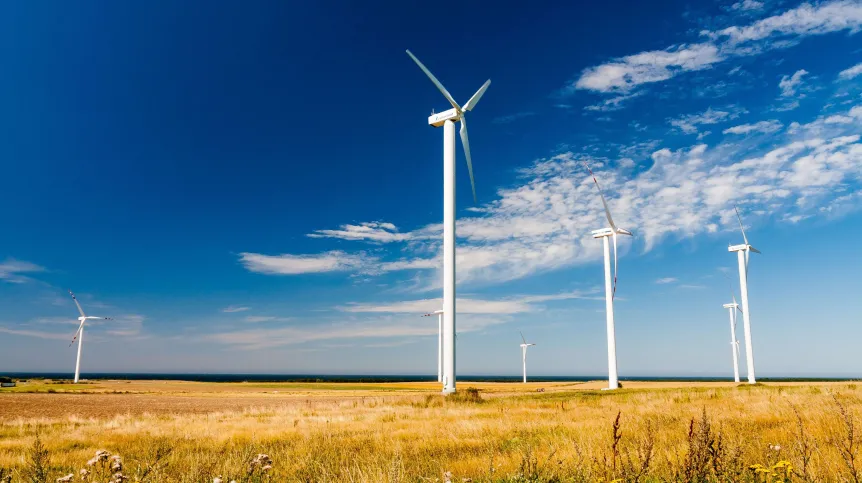
An interdepartmental research team from Gdańsk University of Technology is looking for ways to recycle end-of-life wind turbine blades as energy-efficiently as possible. The researchers hope that their solutions will not only help to protect the environment, but also increase the availability of building materials.
Research team from the Faculty of Civil and Environmental Engineering and the Faculty of Architecture is working on a wind turbine blade recycling system allowing to reuse them in construction industry and architecture, the press office of the Gdańsk University of Technology announced in a press release.
Wind turbine blades are primarily made of polymer composite material. “They are mainly layered structures, consisting of glass and carbon fabrics and resin,” explains Professor Magdalena Rucka, the project manager and head of the Department of Mechanics of Materials and Structures at the Gdańsk University of Technology.
She adds that due to their high fibre content, turbine blades have a very high strength-to-weight ratio and excellent load-bearing capacity and durability. These features simultaneously make them difficult to recycle.
According to the release, blades are designed to last an average of 20-25 years, and should be disposed of after they reach the end of their lifespan.
“Currently, they end up in landfills or are recycled using mechanical, thermal or chemical methods,” says Professor Rucka.
She believes that 'many of these approaches are energy-intensive and environmentally unfriendly'.
“In our project, we want to propose a comprehensive approach to blade recycling that is as low-energy as possible compared to current methods, which will take advantage of the high load-bearing capacity of the blade and, as a result, contribute to reducing current problems in the construction industry, including those related to the limited availability of certain materials,” Rucka explains.
The project was divided into three parallel parts, in which researcher teams will develop a methodology for several variants of wind turbine blade repurposing.
The first scope of the project will be conducted by architects and managed by Dr. Monika Zielińska, who announced an open architectural competition for a concept of repurposing wind turbine blades for elements of street furniture, including a bicycle shelter which could be placed on the campus.
In the second part, managed by Dr. Mikołaj Miśkiewicz from the Gdańsk University of Technology, the researchers will estimate the possibility of using fragments of the blades as load bearing elements in construction and infrastructure. They will develop, for example, a concept of a pedestrian bridge girder.
Dr. Miśkiewicz says that currently there are no systematized types of wind turbine blades, each is an independent structure that can have different applications. “We plan to develop a methodology for proceeding with them,” he adds.
He explains that researchers will evaluate the condition of the blades after reaching their lifespan. “If all or most of the blade can be used for structural applications, taking into account possible damage and delamination of the material, we will be able to make structural elements and street furniture elements,” he emphasises.
Among the potential applications for larger fragments of the material, the researchers also mention all kinds of roofing, including passageways, fences, climbing walls, foundation structures.
“However, if the condition of the blade that we receive for processing does not allow it to be used in this way, we have recognized the directions of proceeding that will enable us to grind the blade and use it as aggregate,” says Dr. Miśkiewicz.
The third part of the project, conducted under the supervision of Dr. Marzena Kurpińska, will consist in assessing the possibility of using ground parts of blades as a substitute for concrete aggregate. The researchers estimate that ground blades could contribute up to 40 percent of the volume of natural aggregate used to make concrete mix in engineering structures, while maintaining the strength properties and durability of concrete.
Dr. Kurpińska that extraction of natural aggregates and their refining by washing and crushing for the production of concrete requires a lot of energy. “Moreover, in some regions there are problems with the availability of some aggregate fractions,” she points out.
She adds that the researchers see the possibility of replacing some of the aggregate with recycled blades. “The initial studies we conducted are promising. We still have time-consuming durability tests ahead of us, as a result of which we will be able to determine the usefulness of the cement composite modified in this way,” she explains.
The scientists emphasize that the disposal of wind turbine blades is a global problem.
“We anticipate that in Poland, due to the development of wind energy, including offshore, this problem will also increase, and then we will propose ready-made solutions,” explains Professor Rucka.
She adds that blade recycling is an important topic that is discussed in many centres around the world, but many aspects are not yet fully explored or can be approached in a different way. “Our research is focused on that,” says the project leader. (PAP)
author: Piotr Mirowicz
pm/ zan/ kap/
tr. RL













